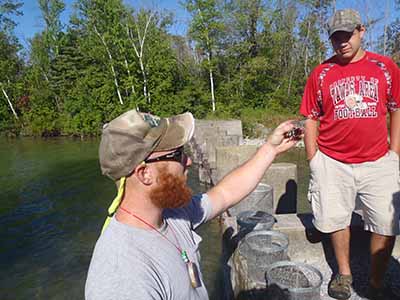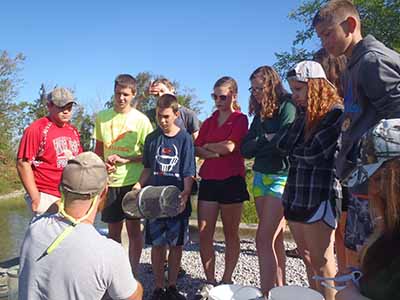Researching crayfish at Great Lakes and Natural Resources Camp
Youth at the Great Lakes and Natural Resources Camp learned about the invasion of crayfish while engaging in real life research.

Youth at the Michigan State University Extension Great Lakes and Natural Resources Camp in Presque Isle, Michigan, engaged in real life research by learning about the invasion of rusty crayfish with Kelley Smith, a researcher focusing on the movement and location of this invasive species. The rusty crayfish was a common bait and aquarium crayfish for many years and is still sold in some bait and aquarium supply shops. This invasive rusty crayfish grows faster, has larger claws and is more aggressive than our native crayfish. Youth from across Michigan helped Smith gather more data as part of their camp experience.
Each day, a different group of campers went with Smith, fisheries biologist Corey Higley and myself to one of five different sampling sites. Youth collected crayfish at all five sites, finding two common native species and a few rusty crayfish. Youth learned how to determine if a crayfish was male or female and how to correctly discern the crayfish’s species. They learned proper terms for crayfish anatomy, such as rostrum for the head and carapace for the body. For the purposes of this study, they measured the crayfish from the tip of the rostrum to the edge of the carapace rather than the total length. This measurement is a more accurate gauge of crayfish size.

Kelley Smith showing a crayfish to campers.
Youth collected, sexed, identified and helped measure over 650 crayfish from sites ranging from Alpena’s Thunder Bay River to Roger City’s Trout River. Overall, campers were excited to find only eight of the invasive rusty crayfish, all in the Thunder Bay River. The data youth collected during the Great Lakes and Natural Resources Camp will be included in the master’s thesis Smith submits at MSU for his master’s degree. Smith cheerfully tells youth he began practice for his job when he was 4 years old and caught his first crayfish.

Kelley Smith explaining crayfish to campers.
Each year, campers at the Great Lakes and Natural Resources Camp have the opportunity to work with researchers doing real world data collection. Youth learn about the research, career paths, scientific process and data collecting protocols, making this camp unique among camps across Michigan.
You can help youth learn more about the rusty crawfish by visiting the Michigan Department of Natural Resources website and the U.S. Department of Agriculture website. To learn more about engaging youth in an exploration of Great Lake aquatic ecosystems, check out the Great Lakes Literacy Principles. To discover more ways to increase science literacy with youth in your life, explore the MSU Extension Science and Technology website. For more information about 4-H learning opportunities and other 4-H programs, contact your county MSU Extension office.



 Print
Print Email
Email



